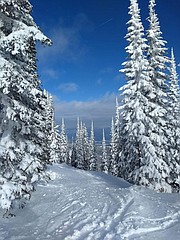Idaho in lead for 2020 avalanche deaths
BONNERS FERRY — For the many people who enjoy the remote backcountry of Boundary County during the winter months, venturing out on skis, snowshoes and snowmobiles, there exists a quiet, lingering threat building on the mountains — the chance of an avalanche.
Idaho is ranked at number seven, out of 12 states, for avalanche fatalities from 2009-10 to 2018-19, according to statistics provided by the Colorado Avalanche Information Center. Colorado was ranked first with 61 deaths. The data shows that the months of January, February, and March are most dangerous.
According to the data, there were three deaths in Idaho as a result of avalanches in 2018, and one person in 2019 has died.
The avalanche fatality numbers for 2020 have placed Idaho and Montana in the lead for avalanche deaths to date. The Kellogg, Idaho area avalanche, which occurred earlier this month at Silver Mountain ski resort, killed three skiers. Annually in the U.S., 20 to 40 people die as a result of avalanches, as reported by backcountry.com.
Simply defined, at avalanche.org, an avalanche is a mass of snow moving down a slope.
The Kellogg avalanche was ruled to have been triggered by the movement of the skiers. Backcoutry.com wrote, “90 percent of deaths are from slides triggered by the victim or members of the victim’s group.”
Knowing what to look for, understanding how avalanche conditions build, having access to up to date information on possible avalanche conditions, finding and attending an avalanche safety course or even just finding free information via educational videos on avalanche and back-country winter safety is paramount to your safety, the safety of the people you are with, and your life.
Avalanches occur for a variety of reasons.
Backcoutry.com has compiled a wealth of information on avalanche safety, with easy to follow infographic material as well as links to avalanche class resources. The following are red flags to look out for and avoid while enjoying your time in the mountains.
Warmer temperatures can cause snow to move to what is termed a wet-slide avalanche which is able to occur without human cause.
Wind loading, or winds blowing snow onto slopes, can overload leeward slopes. This can happen even when it is not snowing.
Persistent weak layers that are in the snow are a concern as they can trigger a slide long after a storm has come and gone. This can happen weeks later and also when there are no other red flags.
Recent avalanches are indications that more avalanches are likely to occur in that area.
Look for signs of unstable snow like cracking or snow that is collapsing. You may be able to hear what is described as “hollow, whumping, sounds.”
Just because it is sunny outside does not mean that you are safe from avalanches. Avalanches can be, and are often, triggered by a recent storm; likely the day after, because of significant snow loading.
There are a host of avalanche classes to take to learn safe traversing of the area in the winter season. Courses will speak to a number of safety plans, how to spot dangerous conditions, preparedness information, how to help avalanche victims, and will include practice with avalanche safety equipment such as transceiver beacons and probes.
Schweitzer Mountain hosts a class delivered by certified American Institute for Avalanche Research and Education providers for a fee, and they also provide a free avalanche transceiver training with the Schweitzer Ski Patrol every Sunday at 10 a.m.
The stakes are high in avalanche country.
One person, with little to no training, can be a negative detriment to their friends and family who are travelling with them. Endangering yourself and others due to lack of avalanche training is easily mitigated by taking a formal class and procuring the right equipment before a disaster occurs.
For more information or to check on current avalanche conditions: www.idahopanhandle avalanche.org



